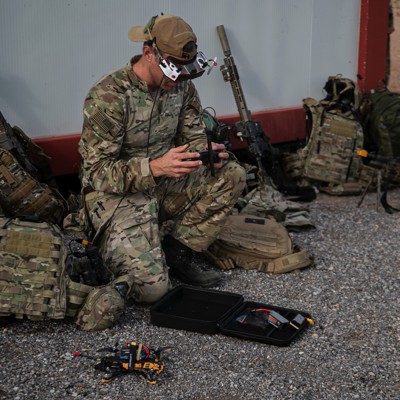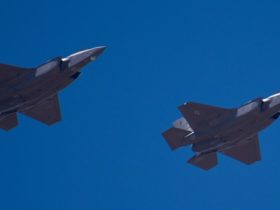Two types of small quadcopter-type drones—first-person-view and tethered—may vault from curiosities to formal, funded Army gear next year, a service official said.
“We are aggressively seeking to have both of those” as programs of record in fiscal year 2025, said Lt. Col. Michael Brabner, who manages small-drone requirements within the Army’s Maneuver Capabilities Development and Integration Directorate. The goal would be to then field FPVs to a unit by fiscal year 2026, he added.
Infantry platoons would operate first-person view drones, or FPVs, while armored units would use tethered drones, Brabner said in a Friday interview.
FPVs rose to prominence in Ukraine after soldiers on both sides began using them to take out enemy vehicles that are far more expensive than the $400-and-up quadcopters. And U.S. Army units have experimented with tethered drones, which draw upon their wired power supply to remain aloft for long periods of time.
The Army requirement for the FPV would likely seek a modular payload system that would allow soldiers to use either anti-personnel or anti-materiel explosives, said Brabner.
“It’s going to be a multi-tool in terms of lethality at that small tactical squad or platoon level,” he said.
An FPV program would be separate from the Army’s Low Altitude Stalking and Strike Ordnance (LASSO) program, which seeks to equip Army units with a loitering munition. The LASSO program will first test AeroVironment’s Switchblade 600, which is several times the size of an FPV and is designed to take out tanks.
The Marine Corp is also experimenting with loitering munitions, with plans to field a squad-level weapon by 2027. In April, the Corps announced that three companies—AeroVironment, Anduril Industries, and Teledyne FLIR—would compete for a potential $249 million contract.
All these loitering munitions are far more expensive than Ukraine’s FPVs; the Switchblade 600, for example, likely costs over $80,000. However, they also sport more sophisticated features, including encrypted communications and more than double the range.
Brabner did not state a target price but said that the FPVs should be “attritable, consumable, and expendable.”
Still, the U.S. isn’t looking to duplicate Ukraine’s home-made, ad-hoc approach. “The armaments will be able to be safely affixed to them and then put into the air,” he said. “That’s where we have to go through fuze safety, air-worthiness, insensitive-munition compliance.”
The Army also isn’t seeking to swarm the battlefield with more drones than enemies can, Brabner added. “We are not trying to achieve parity,“ he said. “We are trying to achieve decisive overmatch.”
Brabner said drones might provide an edge in reconnaissance, communication extension relays, electronic warfare, and lethal strikes.
The Army is also experimenting with reconnaissance quadcopters modified to drop munitions, as is done in both Ukraine and Myanmar. His office has worked with the 82nd Airborne to rig Skydio RQ-28a quadcopters to drop live M-67 fragmentation grenades, he said.
It’s unclear what firms might provide the FPVs. The U.S. military faces restrictions on Chinese drones, where many FPV manufacturers are based. A number of U.S. drone companies have stepped in to serve the defense sector, although some have seen their drones face problems when exposed to combat in Ukraine.
In tandem with the FPV fielding, the Maneuver Center of Excellence is also seeking to launch a new FPV course for soldiers, said Staff Sgt. Adrian O’Neal, who is involved in crafting the program of instruction. The school would be launched in early fiscal 2025 at the earliest, according to Brabner.
The school might consist of three or four weeks of instruction, O’Neal said, consisting of flying them and executing strikes. FPV instruction is also part of the Army Special Operations Forces’ Robotics and Unmanned Systems Integration Course, a six week course that teaches students to use drones and ground robots.
O’Neal framed FPVs as useful for attacking targets of opportunity, as well as performing reconnaissance in areas where enemy air defenses were active. “I can zip around,” said O’Neil. “I can avoid being shot at and I don’t care if it gets shot down.”
Read the full article here



:quality(70)/cloudfront-us-east-1.images.arcpublishing.com/archetype/L7J77CMOA5AT7EQPFKFKHH474Y.jpg)
:quality(70)/cloudfront-us-east-1.images.arcpublishing.com/archetype/TWXAWVZ3MZCG5HTEQ5AXCSYN4I.JPG)
:quality(70)/cloudfront-us-east-1.images.arcpublishing.com/archetype/T4SU6FOBXJBDVDEIE2CV2QJMFY.jpg)
:quality(70)/cloudfront-us-east-1.images.arcpublishing.com/archetype/6GNCPHURV5HZLIKLFVDVWZJHCQ.jpg)
Leave a Reply